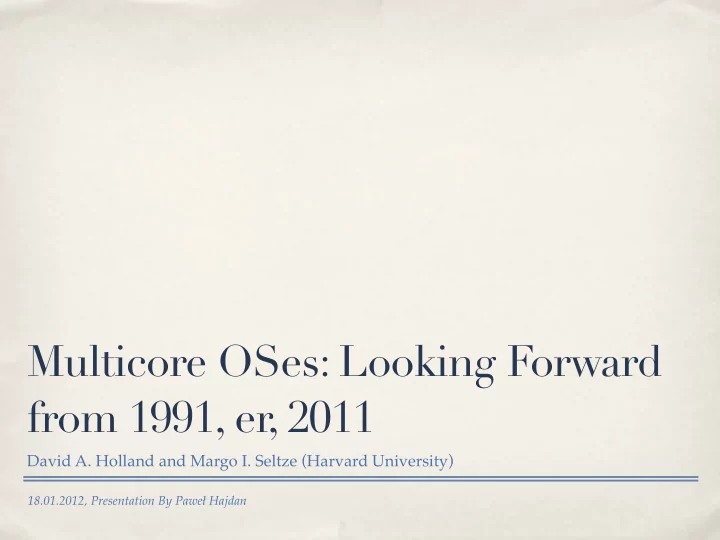

Multicore OSes: Looking Forward from 1991, er, 2011 David A. Holland and Margo I. Seltze (Harvard University) 18.01.2012, Presentation By Pawe ł Hajdan
software is not parallelized enough to take advantage ✤ of the more and more parallelized hardware how about moving to a shared-nothing architecture ✤ which is easier to scale?
But we’ve been there before! supercomputers of ‘80s and ‘90s hit similar problems ✤ shared-memory replaced by shared-nothing + message passing ✤ Map-Reduce is shared-nothing and hugely successful ✤ don’t take the analogy too far ✤
Make messaging really cheap support messaging natively ✤ cost comparable to a procedure call ✤
Make messaging really cheap not just applications, operating systems too ✤ procedure calls are a special case of messages ✤ microkernel, “macrokernel”, or something completely different ✤
A Model of Messages and Channels channel <- value (send) ✤ value <- channel (receive) ✤ channels can be sent though channels ✤ communication and also synchronization ✤
Multiplexing choose { option r1 <- c1: action1(r1); break; option r2 <- c2: action2(r2); break; option r3 <- c3: action3(r3); break; };
Peer vs. Hierarchical Structure caller/callee relationship is asymmetric ✤ this leads to a hierarchy ✤ which can become cumbersome or wasteful ✤
Implementing it UNIX and C ✤ needed in mainstream, must run legacy code easily ✤ concurrent dialect of C, lightweight parallelism ✤ more details are beyond the scope ✤
Implementing it no kernel-mode/user-mode transitions ✤ no signals for asynchronous kernel -> app messaging ✤ designated kernel and application cores ✤ no need for special hardware support, for now ✤
Implementing it the whole kernel must be architected to use message passing ✤ give every device driver its own thread ✤ less synchronization, cool! ✤ better fits static analysis models ✤
Implementation issues most can only be discovered during actual implementation ✤ implementing choice effectively ✤ decentralizing virtual memory management ✤ too much parallelism and no middle ground ✤
Implementation issues recovering from various failure scenarios ✤ scheduling threads on CPU cores ✤ scaling still not automatic, just easier ✤
Conclusions lightweight shared-nothing message-passing parallelism ✤ alternatives like hundreds of VMs are unsatisfying ✤ is systems research community ready for the challenge? ✤
Further reading BAUMANN, A., ET AL. The Multikernel: A new OS architecture for ✤ scalable multicore systems. In Proc. of the 22nd SOSP (October 2009). (Barrelfish, Microsoft Research, Cambridge) CLARK, J. Intel: Why a 1,000-core chip is feasible (December 2010). ✤ (48 and 80 cores already there; how do we program 1000 core chip?) GOOGLE. The Go programming language. http://golang.org/ ✤ Jochen Liedtke’s papers (microkernels, L4) (1991 - 2001) ✤ Pierre-Evariste Dagan. Language Support for Reliable Operating ✤ Systems (June 2009).
THE END
Recommend
More recommend